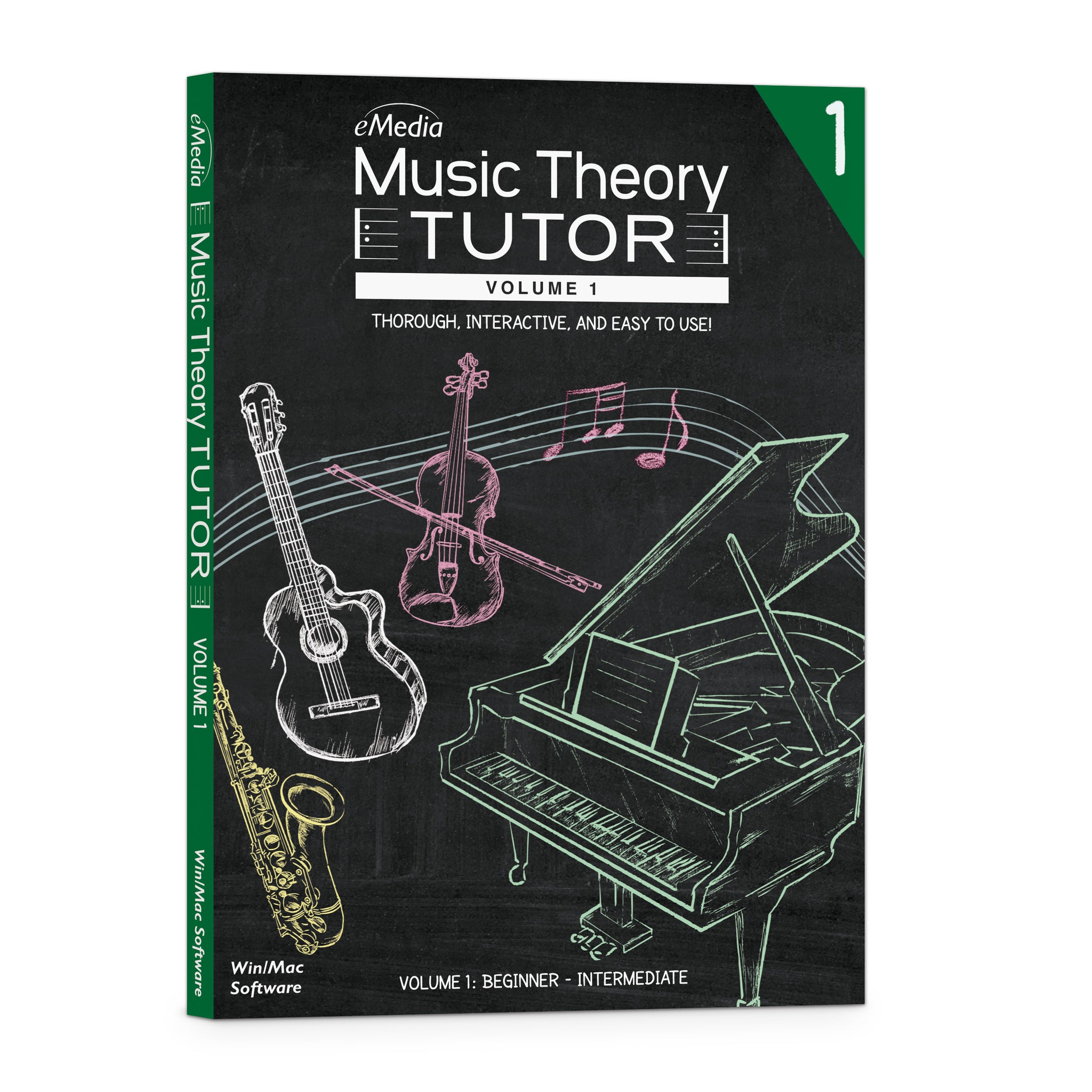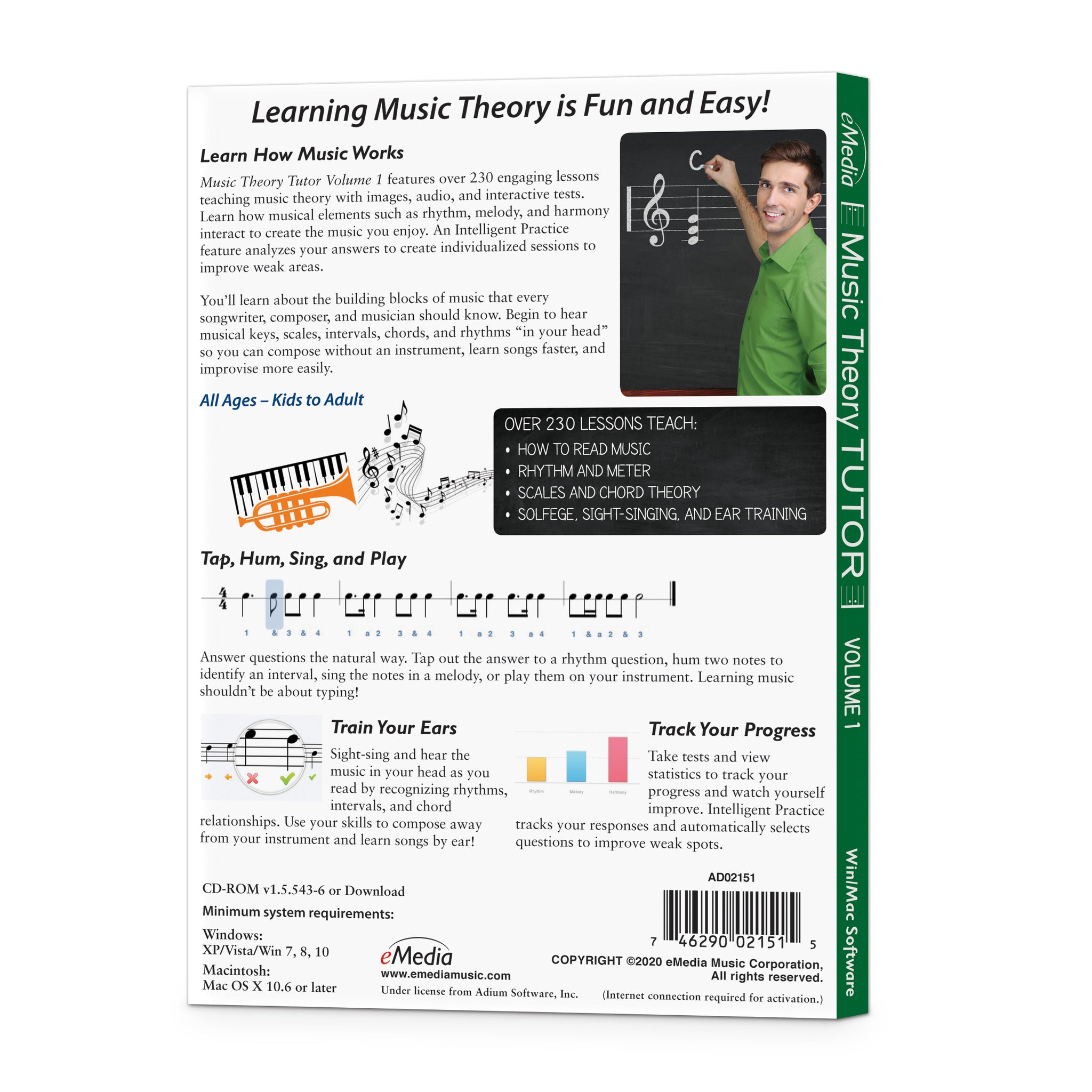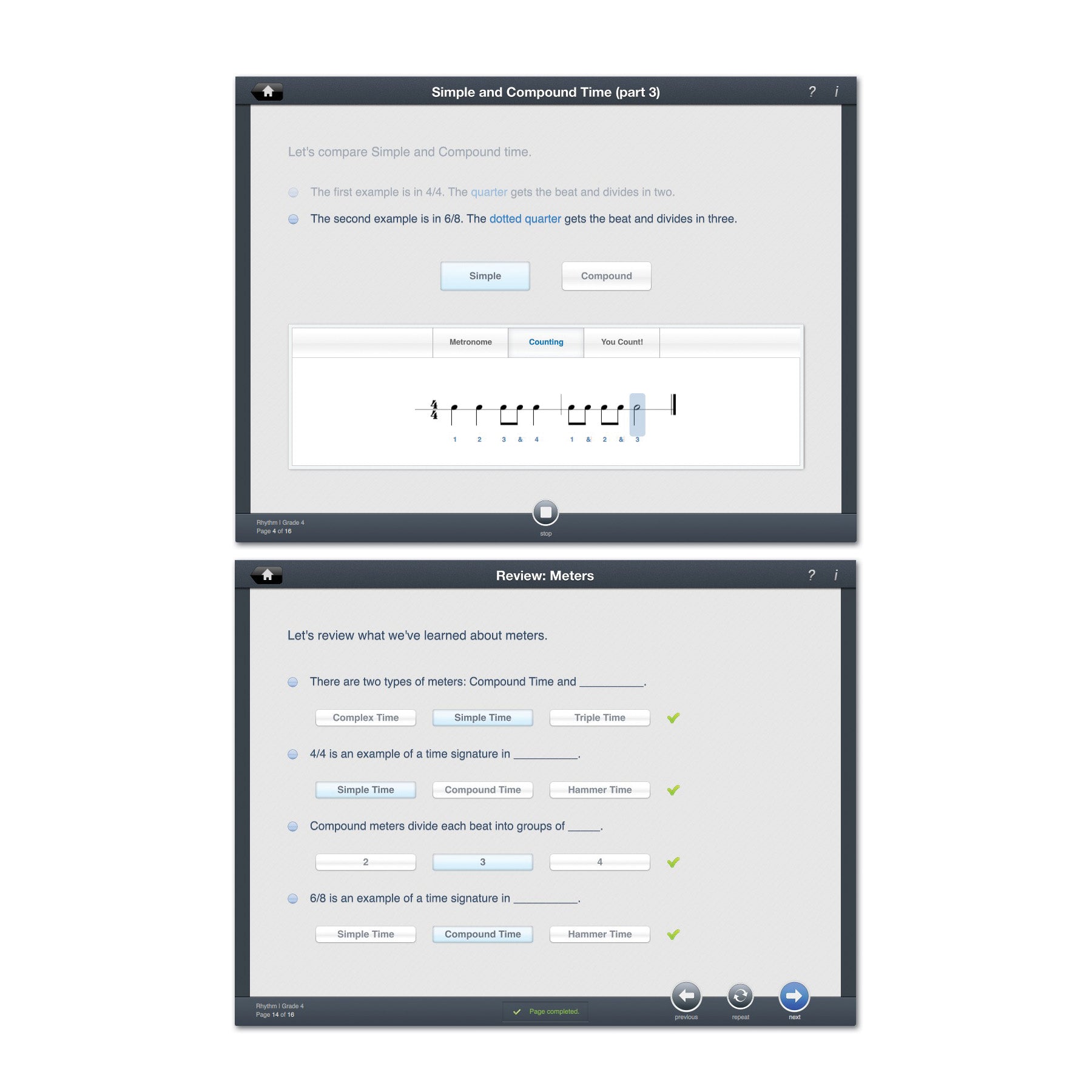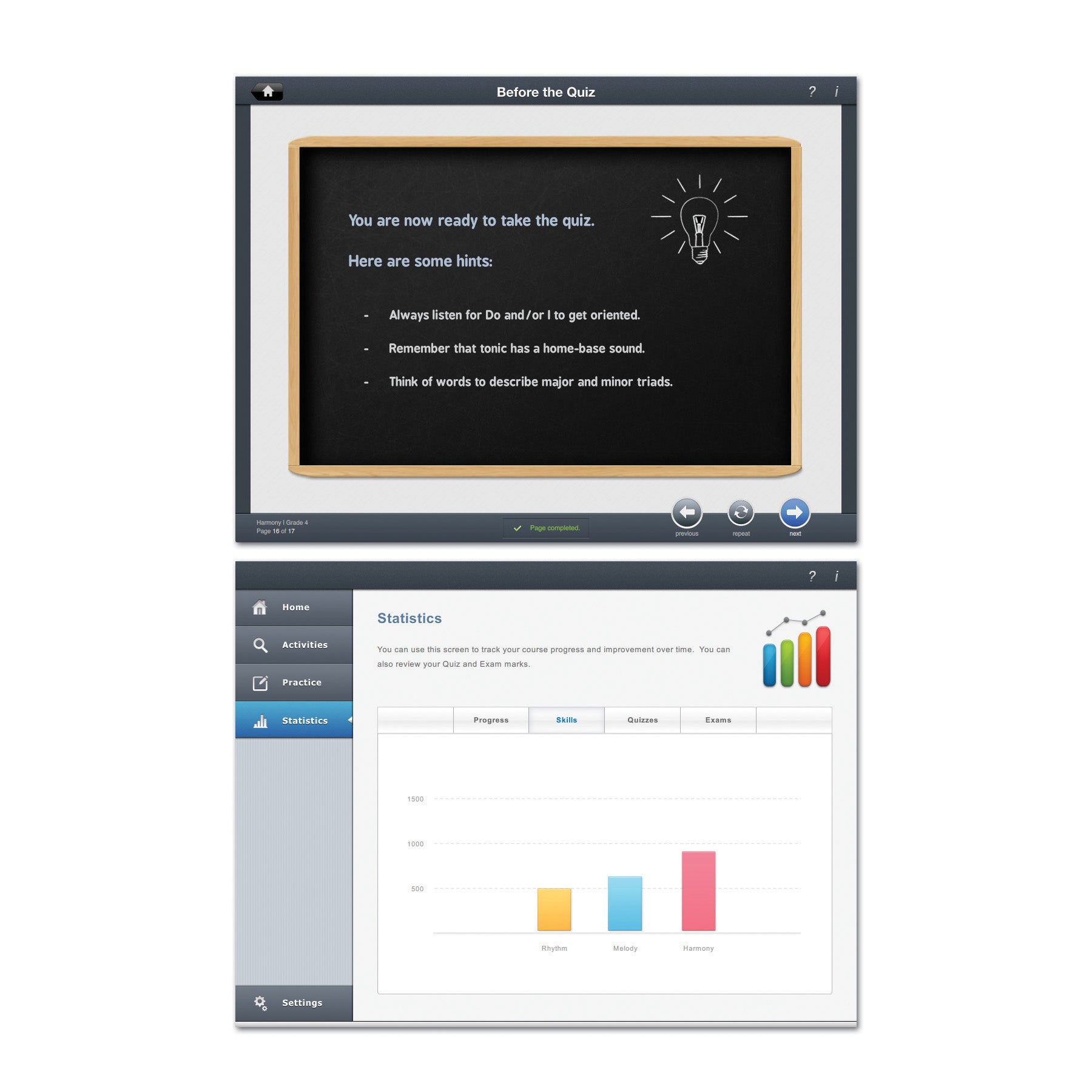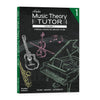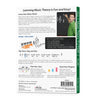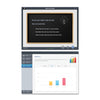eMedia Music Theory Tutor, Volume 1
“Offers a thoughtful, step-by-step introduction to ear training.”
– Dr. Erik Steighner, saxophonist and music teacher
- SKU: AD02151DLW
Discount Code Found:
However, this item is currently on sale, and discount codes may not be combined with other offers.
Click ‘Add to Cart.’ Then ‘Go to Cart’ and click ‘Proceed to Checkout’ to see it applied on the next page (if applicable to your order). Discount codes may not be combined with other offers.
Click ‘Add to Cart.’ Then ‘Go to Cart’ and click ‘Proceed to Checkout’ to see it applied on the next page (if applicable to your order).
Music Theory for Beginners, Learning Music is Easier Than Ever!
eMedia Music Theory Tutor Volume 1 features over 230 engaging music theory lessons that teach with images, audio, interactive tests, and practical music theory. It’s is the ideal approach to learning music theory for beginners. An Intelligent Practice offers optimized practice sessions based on your responses and skill level to help you learn music theory elements such as rhythm, melody, and harmony.
eMedia Music Theory Tutor shows you when you are playing or singing the correct pitches in a lesson and lets you see your progress. Many lessons let you respond by humming, singing, or playing your instrument into the computer's microphone. Tap rhythms, sing back melodies, guess intervals, and much more! Gain confidence as you pass each music theory quiz at the end of a subject and ace tests at the end of every grade level completion. Learn how to read music, basic chord theory, scale theory, and the building blocks of music. Learn music theory to hear melodies, scales, intervals, chords, and rhythms in your head so you can compose without an instrument and learn songs faster.
Features include:
- Learn music theory with a step-by-step curriculum designed by Dr. Gregory Simon, who has a Ph.D. in music composition from University of Michigan who has taught at the University of Colorado.
- Intelligent Practice tracks your progress as you learn music theory and automatically selects questions to improve weak spots.
- Both music theory lessons and basic ear training combined into one music theory software solution.
- The ability to view music theory quiz scores and other statistics to measure your progress.
- Satisfies Canadian school requirements for music grades 1-5.
- Covers rhythm fundamentals including tempo, counting beats, measures, and values for notes and rests.
- Teaches recognition of simple and compound time signatures (including 4/4, 3/4, 9/8, and cut time).
- Interactive music theory software for learning to read music, including clefs, note pitches, names, and note rhythmic values including dotted and beamed notes.
- Ear training exercises to recognize note direction and motion, notes, intervals, and scales plus major, minor, and diminished chords.
- Lessons on major and minor scale construction, and intervals (perfect fourths, fifths, tritones, etc.).
- Music theory lessons covering the roles of melody and harmony roles, unstable notes and note resolution.
- Chord theory lessons on creating major scale triads (major, minor, and diminished chords), chord progression theory based on the major scale, chord functions within progressions (tonic, dominant, subdominant, etc.), and the Roman numeral system (I, IV, V, etc.).
- Solfege and sight-singing.

eMedia Music Theory Tutor Volume 1 features over 230 engaging music theory lessons that teach rhythm, melody, and harmony with images, audio, and interactivity. Learn to read music notation and how music is constructed. Train your ear to hear scales, intervals, chords, and rhythms “in your head.” These skills will help you to compose (with or without an instrument), improvise, and learn songs by ear faster.
Learn to Read & Hear Rhythms, Intervals, Scales, Chords, and Chord Progressions. Use sight-tapping to practice reading rhythms and Rhythm Imitation studies help you recognize rhythmic figures. Lessons covering interval and chord recognition help you develop a great sense of relative pitch to identify melodies, scales, chords, and progressions.
An Intelligent Practice feature tracks your progress and automatically adjusts exercises to improve your weak spots, as a real instructor would do. Want to practice something specific? Use Custom Practice and select the items you want. Gain confidence as you pass quizzes and ace tests at the end of every grade level completion.
Use Solfege to Sight-Sing and Hear the Music “In Your Head”. Build interval-singing and sight-singing skills, and you’ll know how compositions sound by simply seeing the sheet music.
Scores and Statistics Mark Your Progress Through the Course. Green checkmarks highlight correct answers, and you can retake quizzes to improve your score. With the built-in statistics, you can review your progress and test scores. You see where your answers were correct, and charts show your overall progress.
eMedia Music Theory Tutor is developed by Adium Software.
Attention Educators, please visit our academic product page for information on using this product in schools or for private group instruction.
Also available: eMedia Music Theory Tutor Volume 2 and eMedia Music Theory Tutor Complete – a 2 Volume set featuring both Levels 1 and 2.
Music Theory for Beginners, Learning Music is Easier Than Ever!
eMedia Music Theory Tutor Volume 1 features over 230 engaging music theory lessons that teach with images, audio, interactive tests, and practical music theory. It’s is the ideal approach to learning music theory for beginners. An Intelligent Practice offers optimized practice sessions based on your responses and skill level to help you learn music theory elements such as rhythm, melody, and harmony.
eMedia Music Theory Tutor shows you when you are playing or singing the correct pitches in a lesson and lets you see your progress. Many lessons let you respond by humming, singing, or playing your instrument into the computer's microphone. Tap rhythms, sing back melodies, guess intervals, and much more! Gain confidence as you pass each music theory quiz at the end of a subject and ace tests at the end of every grade level completion. Learn how to read music, basic chord theory, scale theory, and the building blocks of music. Learn music theory to hear melodies, scales, intervals, chords, and rhythms in your head so you can compose without an instrument and learn songs faster.
Features include:
- Learn music theory with a step-by-step curriculum designed by Dr. Gregory Simon, who has a Ph.D. in music composition from University of Michigan who has taught at the University of Colorado.
- Intelligent Practice tracks your progress as you learn music theory and automatically selects questions to improve weak spots.
- Both music theory lessons and basic ear training combined into one music theory software solution.
- The ability to view music theory quiz scores and other statistics to measure your progress.
- Satisfies Canadian school requirements for music grades 1-5.
- Covers rhythm fundamentals including tempo, counting beats, measures, and values for notes and rests.
- Teaches recognition of simple and compound time signatures (including 4/4, 3/4, 9/8, and cut time).
- Interactive music theory software for learning to read music, including clefs, note pitches, names, and note rhythmic values including dotted and beamed notes.
- Ear training exercises to recognize note direction and motion, notes, intervals, and scales plus major, minor, and diminished chords.
- Lessons on major and minor scale construction, and intervals (perfect fourths, fifths, tritones, etc.).
- Music theory lessons covering the roles of melody and harmony roles, unstable notes and note resolution.
- Chord theory lessons on creating major scale triads (major, minor, and diminished chords), chord progression theory based on the major scale, chord functions within progressions (tonic, dominant, subdominant, etc.), and the Roman numeral system (I, IV, V, etc.).
- Solfege and sight-singing.

eMedia Music Theory Tutor Volume 1 features over 230 engaging music theory lessons that teach rhythm, melody, and harmony with images, audio, and interactivity. Learn to read music notation and how music is constructed. Train your ear to hear scales, intervals, chords, and rhythms “in your head.” These skills will help you to compose (with or without an instrument), improvise, and learn songs by ear faster.
Learn to Read & Hear Rhythms, Intervals, Scales, Chords, and Chord Progressions. Use sight-tapping to practice reading rhythms and Rhythm Imitation studies help you recognize rhythmic figures. Lessons covering interval and chord recognition help you develop a great sense of relative pitch to identify melodies, scales, chords, and progressions.
An Intelligent Practice feature tracks your progress and automatically adjusts exercises to improve your weak spots, as a real instructor would do. Want to practice something specific? Use Custom Practice and select the items you want. Gain confidence as you pass quizzes and ace tests at the end of every grade level completion.
Use Solfege to Sight-Sing and Hear the Music “In Your Head”. Build interval-singing and sight-singing skills, and you’ll know how compositions sound by simply seeing the sheet music.
Scores and Statistics Mark Your Progress Through the Course. Green checkmarks highlight correct answers, and you can retake quizzes to improve your score. With the built-in statistics, you can review your progress and test scores. You see where your answers were correct, and charts show your overall progress.
eMedia Music Theory Tutor is developed by Adium Software.
Attention Educators, please visit our academic product page for information on using this product in schools or for private group instruction.
Also available: eMedia Music Theory Tutor Volume 2 and eMedia Music Theory Tutor Complete – a 2 Volume set featuring both Levels 1 and 2.
Contents Summary
Grade 1
Rhythm
- Introduction
- Beat
- Beat Counting
- Tempos
- Exercise: Beat Tapping
- Bars
- Note Duration
- Exercise: Note Tapping
- Time Signatures
- Time Signatures (part 2)
- Time Signatures (part 3)
- Time Signatures (part 4)
- Exercise: Meter Recognition
- Eighth Notes
- Eighth Notes (part 2)
- Exercise: Note Tapping 2
- Exercise: Rhythm Sight Tapping
- Review: Time Signatures and Bars
- Before the Quiz
- Quiz
Melody
- Introduction
- Getting Started
- Pitch
- Exercise: Pitch Singing
- Exercise: Pitch Comparison
- The Staff and Ledger Lines
- Treble Clef
- Direction
- Exercise: Motion Recognition
- Steps and Skips
- Steps and Skips (part 2)
- Exercise: Motion Recognition 2
- Intervals
- Intervals (part 2)
- Intervals (part 3)
- Exercise: Interval Singing
- Review: Pitch and Direction
- Before the Quiz
- Quiz
Grade 2
Rhythm
- Introduction
- Tempo Markings
- Rests
- Rests (part 2)
- Rests (part 3)
- Rests (part 4)
- Exercise: Rhythm Sight Tapping
- 3/4 Time Signature
- 16th Notes
- Exercise: Note Tapping
- Dotted Notes
- Dotted Notes (part 2)
- Ties
- Ties (part 2)
- Exercise: Rhythm Sight Tapping 2
- Review: Rests and Dotted Rhythms
- Before the Quiz
- Quiz
Melody
- Introduction
- Half Steps and Whole Steps
- Half Steps and Whole Steps (part 2)
- Exercise: Motion Recognition
- Octave Skip
- Exercise: Motion Recognition 2
- Major Scale
- Major Scale (part 2)
- Using Solfege
- Using Solfege (part 2)
- Using Solfege (part 3)
- Using Solfege (part 4)
- Exercise: Scale Singing
- Intervals - Fourth
- Intervals - Fifth
- Exercise: Interval Singing
- Exercise: Interval Recognition
- Bass Clef
- Grand Staff + Middle C
- Melody Workshop
- Exercise: Melody Imitation
- Review: Solfege
- Before the Quiz
- Quiz
Grade 3
Rhythm
- Introduction
- Dotted Eighth Notes
- Dotted Eighth Notes (part 2)
- Exercise: Rhythm Sight Tapping
- Pickup Notes
- Exercise: Rhythm Sight Tapping 2
- 4/8 Time Signature
- 4/8 Time Signature (part 2)
- Cut Time
- Cut Time (part 2)
- Exercise: Rhythm Sight Tapping 3
- Rhythm Workshop
- Rhythm Workshop (part 2)
- Review: 4/8 and Cut Time
- Before the Quiz
- Quiz
Melody
- Introduction
- Review: Major Scale
- Exercise: Scale Singing
- Note Stability
- Stable Notes
- Exercise: Sight Singing
- Unstable Notes
- Resolution
- Exercise: Sight Singing 2
- Intervals - Sixth
- Intervals - Seventh
- Intervals - Major and Minor
- Intervals - Major and Minor (part 2)
- Exercise: Interval Recognition
- C Clef
- C Clef (part 2)
- Melody Workshop
- Exercise: Melody Imitation
- Review: Stability and Resolution
- Before the Quiz
- Quiz
Harmony
- Introduction
- Melody vs Harmony
- Chords
- Major Triads
- Building a Major Triad
- Building a Major Triad (part 2)
- Minor Triads
- Arpeggios
- Exercise: Arpeggio Singing
- Major vs Minor Triads
- Exercise: Chord Recognition
- Review: Triads
- Before the Quiz
- Quiz
Grade 4
Rhythm
- Introduction
- Simple and Compound Time
- Simple and Compound Time (part 2)
- Simple and Compound Time (part 3)
- Exercise: Meter Recognition
- Exercise: Rhythm Sight Tapping
- Ties Revisited
- Rhythm Workshop
- 32nd Notes
- 32nd Notes (part 2)
- Small Rests
- Exercise: Rhythm Sight Tapping 2
- Exercise: Rhythm Imitation
- Review: Meters
- Before the Quiz
- Quiz
Melody
- Introduction
- Stability and Resolution Revisited
- Exercise: Sight Singing
- Melodic Patterns
- Exercise: Sight Singing 2
- Intervals - Minor Sixth
- Perfect Intervals
- Intervals - Tritone
- Exercise: Interval Recognition
- Exercise: Interval Singing
- Major Scale in Broken Thirds
- Exercise: Scale Singing
- Dynamics
- Dynamics (part 2)
- Melody Workshop
- Exercise: Melody Imitation
- Review: Stable and Unstable Notes
- Before the Quiz
- Quiz
Harmony
- Introduction
- Triads Revisited
- Triads in the Major Scale
- Triads in the Major Scale (part 2)
- Exercise: Chord Recognition
- Keys
- Key Signatures
- Chord Progressions and Function
- Roman Numerals
- Chord Function - Tonic
- Chord Function - Dominant
- Exercise: Chord Function Recognition
- Chord Progression: V - I
- Exercise: Chord Progressions
- Review: Chord Functions
- Before the Quiz
- Quiz
Grade 5
Rhythm
- Introduction
- Beaming in Compound Time
- Counting 16ths in Compound Time
- Siciliano
- Exercise: Rhythm Sight Tapping
- 9/8 Time Signature
- Exercise: Rhythm Sight Tapping 2
- Rhythm Workshop
- Rhythm Workshop (part 2)
- Rhythm Workshop (part 3)
- Exercise: Rhythm Imitation
- Review: Time Signatures
- Before the Quiz
- Quiz
Melody
- Introduction
- Creating Scales
- Major Scale vs Minor Scale
- Major Scale vs Minor Scale (part 2)
- Exercise: Scale Recognition
- Major Scale vs Minor Scale (part 3)
- Major Scale vs Minor Scale (part 4)
- Exercise: Sight Singing
- Diatonic and Chromatic
- Intervals - Major and Minor Seventh
- Intervals - Octave
- Exercise: Interval Singing
- Exercise: Interval Recognition
- Articulation
- Melody Workshop
- Exercise: Melody Imitation
- Review: Minor Scales
- Before the Quiz
- Quiz
Harmony
- Introduction
- Review: Chord Functions
- Chord Function - Subdominant
- Four Part Texture
- Cadences
- Authentic Cadence
- Plagal Cadence
- Exercise: Cadence Recognition
- Diminished Triads
- Exercise: Chord Recognition
- Chord Progression: IV - V
- Exercise: Chord Progressions
- Review: Cadences and Functions
- Before the Quiz
- Quiz
What reviewers are saying...
“Well-thought-out music training application.”
– Softpedia
“Offers a thoughtful, step-by-step introduction to ear training.”
– Dr. Erik Steighner, saxophonist and music teacher
“This is a very, very cool tool for music teachers or any Mac user who wants to improve their singing or understanding of music.”
– Mac360
System requirements
Windows®:Windows 11 / 10 / 8 / 7 / Vista / XP
2.2GHz CPU, 2GB RAM
OpenGL-capable video card and driver
300 MB of hard drive space
Download or CD-ROM
macOS 10.6 or later
2.2GHz CPU, 2GB RAM
300 MB of hard drive space
Download or CD-ROM
Internet connection required for online activation. Requires a Windows desktop, laptop, or tablet device; or a Mac desktop or laptop computer. Not compatible with iPhones, iPads, Android, or Chromebook devices.
Questions about system requirements? Contact our technical support department.

